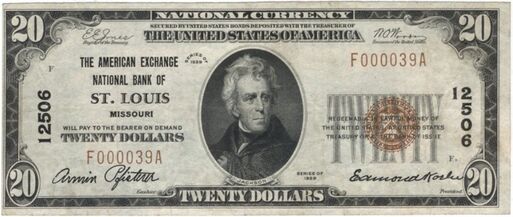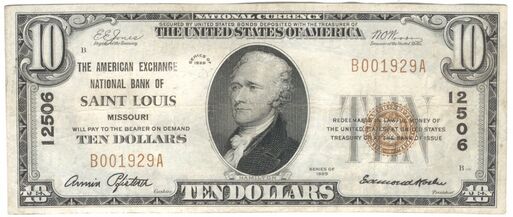American Exchange NB, Saint Louis, MO (Charter 12506)
American Exchange NB of Saint Louis, MO (Chartered 1924 - Receivership 1933)
Town History
St. Louis is the second-largest city in Missouri. It sits near the confluence of the Mississippi and the Missouri Rivers. In 2020, the city proper had a population of 301,578, while the bi-state metropolitan area, which extends into Illinois, had an estimated population of over 2.8 million, making it the largest metropolitan area in Missouri and the second-largest in Illinois.
The founding of St. Louis was preceded by a trading business between Gilbert Antoine de St. Maxent and Pierre Laclède Liguest in the fall of 1763. St. Maxent invested in a Mississippi River expedition led by Laclède, who searched for a location to base the company's fur trading operations. Though Ste. Genevieve was already established as a trading center, he sought a place less prone to flooding. He found an elevated area overlooking the flood plain of the Mississippi River, not far south from its confluence with the Missouri and Illinois rivers. In addition to having an advantageous natural drainage system, there were nearby forested areas to supply timber and grasslands which could easily be converted for agricultural purposes. This place, declared Laclède, “might become, hereafter, one of the finest cities in America.” He dispatched his 14-year-old stepson, Auguste Chouteau, to the site, with the support of 30 settlers in February 1764. Laclède arrived at the future town site two months later and produced a plan for St. Louis based on the New Orleans street plan. The default block size was 240 by 300 feet, with just three long avenues running parallel to the west bank of the Mississippi. He established a public corridor of 300 feet fronting the river, but later this area was released for private development.
St. Louis was transferred to the French First Republic in 1800 (although all of the colonial lands continued to be administered by Spanish officials), then sold by the French to the U.S. in 1803 as part of the Louisiana Purchase. St. Louis became the capital of, and gateway to, the new territory. Shortly after the official transfer of authority was made, the Lewis and Clark Expedition was commissioned by President Thomas Jefferson. The expedition departed from St. Louis in May 1804 along the Missouri River to explore the vast territory.
St. Louis became a major port on the Mississippi River and from 1870 until the 1920 census, it was the fourth-largest city in the country. It separated from St. Louis County in 1877, becoming an independent city and limiting its political boundaries. In 1904, it hosted the Louisiana Purchase Exposition and the Summer Olympics.
Saint Louis had 42 National Banks chartered during the Bank Note Era, and 37 of those banks issued National Bank Notes.
Bank History
- Organized February 19, 1924
- Chartered March 8, 1924
- 2: Conservatorship March 13, 1933
- 2: Receivership December 5, 1933
- 2: Succeeded by 13726 (American Exchange NB in Saint Louis, MO)
- Interior photos of the American Exchange National Bank ca1950s. Seven photos
On March 8, 1924, a charter was issued by the comptroller of the currency creating the American Exchange national Bank of St. Louis, with Edmond Koeln, City Collector, as president. The authorized capital was $200,000. The bank was located at the southeast corner of Kingshighway and Gravois Avenue, the site having been purchased by Koeln, Judge Charles H. Daues and several businessmen of that district last fall. Armin Pfisterer, formerly connected with the First National Bank, was selected as cashier.[1] The formal opening was held on Saturday, March 22nd. A new record was said to have been established in building a structure of this character. The building was designed, built and completely equipped by the St. Louis Bank Equipment Co. in less than 4 1/2 months. The interior fixtures were of imported Italian Botticino marble with bronze wickets. The woodwork was of American walnut. A large painting on the wall above the main entrance depicted the landing of Laclede, founder of St. Louis. The safe deposit vault was guarded with a heavy bronze grille with door under electric control. The vault door was 19 inches thick, weighing 25 tons. The site for the building was purchased through the Walter Scott Realty Co. The officers were Edmond Koeln, president; D. Hedenkamp, first vice president; Walter Scott, second vice president; Armin Pfisterer, cashier. The directors were Judge Charles H. Daues, Oliver G. Chapman, Edmond Koeln, Walter Scott, Fred Ulrich, Thomas Schuetz, D. Hedenkamp, Henry Rueppert, Armin Pfisterer, George Galsch and Dr. A.G. Youngman.[2]
On May 16, 1933, Edmond Koeln, president of the American Exchange National bank, Kingshighway and Gravois Avenue, announced a plan for reopening the depository which had been closed since the bank holiday. A conservator was in charge. The plan called for reorganization with a transfer of sufficient funds into the new institution to pay 80% of all deposits. the remaining 20% was expected to be available later. The losses to the old bank necessitating the reorganization were caused in part by estimated reduction of loan values, but chiefly by the appraisal of bonds at their current, abnormally low values. The new bank would only take over assets specifically approved by the comptroller of the currency at prices approved by the comptroller. The new bank would sell at $33.33 a share, 10,000 shares of stock with a par value of $20 a share. When the capital stock had been subscribed and paid in full, the new bank would be authorized to open for business. The old bank had deposits of $2,082,659.[3]
On Wednesday, July 12, 1933, the reorganized American Exchange National Bank in Saint Louis opened with 80% of general deposits of about $1,300,000 available. The opening of the bank was made possible through sale of stock for $333,000.[4]
Herbert M. Johnson was receiver for the old American exchange National Bank where, by 1936, all depositors and secured claimants were paid in full. In addition, depositors and claimants were paid 6% interest for the full time their money was tied up amounting to more than $51,000.[5]
Official Bank Titles
1: The American Exchange National Bank of St. Louis, MO
2: The American Exchange National Bank of Saint Louis, MO [4/14/1930]
Bank Note Types Issued
A total of $778,720 in National Bank Notes was issued by this bank between 1924 and 1933. This consisted of a total of 99,314 notes (59,576 large size and 39,738 small size notes).
This bank issued the following Types and Denominations of bank notes:
Series/Type Sheet/Denoms Serial#s Sheet Comments 1: 1902 Plain Back 4x5 1 - 9030 1: 1902 Plain Back 3x10-20 1 - 5864 1: 1929 Type 1 6x5 1 - 1532 1: 1929 Type 1 6x10 1 - 768 1: 1929 Type 1 6x20 1 - 260 2: 1929 Type 1 6x5 1533 - 4088 2: 1929 Type 1 6x10 769 - 2032 2: 1929 Type 1 6x20 261 - 503
Bank Presidents and Cashiers
Bank Presidents and Cashiers during the National Bank Note Era (1924 - 1933):
Presidents:
Cashiers:
Other Known Bank Note Signers
- No other known bank note signers for this bank
Bank Note History Links
Sources
- Saint Louis, MO, on Wikipedia
- Don C. Kelly, National Bank Notes, A Guide with Prices. 6th Edition (Oxford, OH: The Paper Money Institute, 2008).
- Dean Oakes and John Hickman, Standard Catalog of National Bank Notes. 2nd Edition (Iola, WI: Krause Publications, 1990).
- Banks & Bankers Historical Database (1782-1935), https://spmc.org/bank-note-history-project
- Interiors of the American Exchange National Bank ca1950s. Seven photos, accessed Feb. 26, 2024.
- ↑ St. Louis Post-Dispatch, St. Louis, MO, Sun., Mar. 9, 1924.
- ↑ St. Louis Post-Dispatch, St. Louis, MO, Sun, Mar. 16, 1924.
- ↑ The St. Louis Star and Times, St. Louis, MO, Tue., May 16, 1933.
- ↑ St. Louis Post-Dispatch, St. Louis, MO, Wed., July 12, 1933.
- ↑ St. Louis Globe-Democrat, St. Louis, MO, Fri., Sep. 25, 1936.




